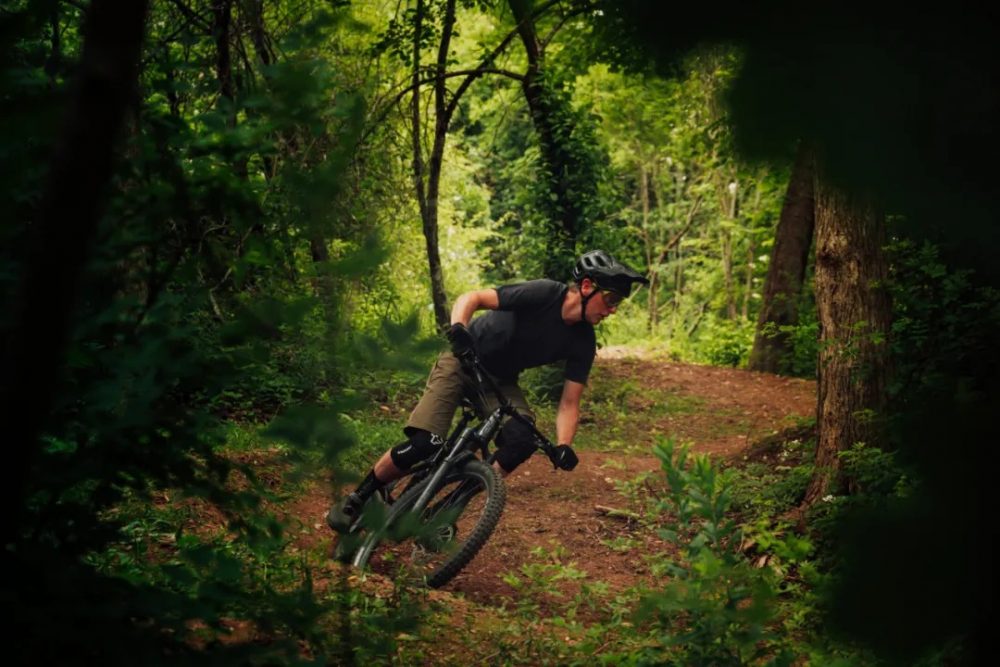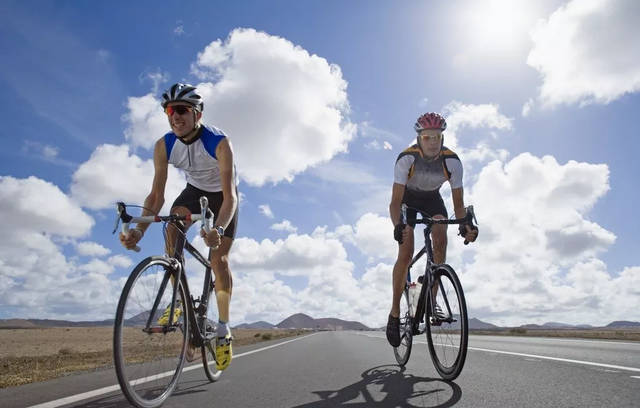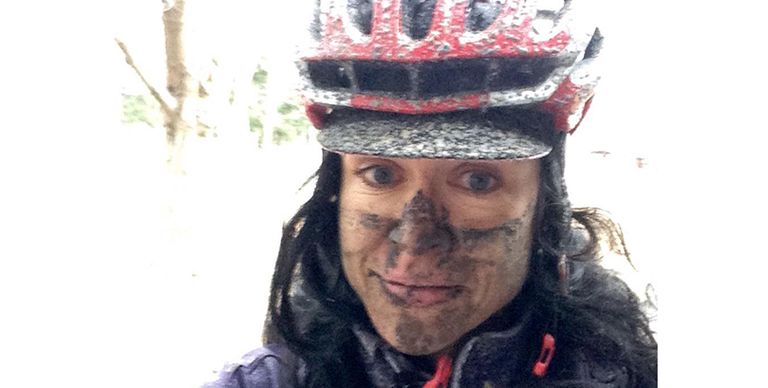
The soft glow of sunrise is just beginning to illuminate the grounds at Washington Crossing Historic Park as I slowly weave my way up the long twisty drive to the upper lot by the pavilion. As I steer my loaded-up Tacoma toward an open bank of parking slots, I burst out laughing—not my usual reaction as I roll into a venue before a big race. But I can’t help myself.
The first thing I see is my friend Garth, who stands at about 6’3”, all lanky arms and legs, rolling along on a hotebike with giant, over-the-top tires, his dreads swinging in the cool December breeze.
He looks a little ridiculous. But of course we all look a little ridiculous, trucking around the parking lot on these tricked-out monster rigs with cartoonishly fat tires, moose mitts, frame bags, and some even with aerobars (yes, on a fat bike). As I pull my own D1 out of the truck and start wheeling about, I catch a glimpse of another friend, Rob, who’s sliding bottles into the cages of his all-carbon, extremely lightweight hotebike A6AH26F.
Rob was the guy who rode and raced these crazy machines long before the rest of us even knew what they were. He was that guy we enjoyed poking a little fun at for riding his odd rig. He looked bemused, like a guy who’s been enjoying his own private party for the past decade—and just saw all his friends crash the gates.
Maybe he likes it, maybe he doesn’t. But it doesn’t matter because there’s no shutting the doors and turning off the lights on this party. We’re here. And we keep coming. Sixty two of us in all, for the inaugural D&L Fat Epic, a 200K (or half-distance 100K for those who aren’t so sure about the whole enchilada) race that runs along the D&L Trail, a historic 165-mile old coal-carrying trail that winds along the banks of the Delaware and Lehigh rivers in Pennsylvania. There isn’t a flake of snow to be found, but nobody seems to mind, as they squeeze each other’s giant tires and debate the merits of running double-digit pressure on what is going to be a fast-rolling ride.

An action cam drone buzzes over us during staging, and we all grin and wave and hoot and holler, anxious to put our fat tires in motion. They say, “Go!” and we’re off. It’s probably the slowest rolling start I’ve been party to. But it doesn’t take long before we’re humming along at a brisk clip of over 17mph, and riders start falling off the back of the pack.
I laugh again. It’s basically a fat bike road race. It’s so dumb, it’s fun. After about 3.5 hours, the pack whittles away until there were are six of us at the turnaround. I get shelled at mile 92 and catch up with another guy who gets spit off the back shortly after. The race comes down to a sprint finish (seriously) at seven hours and change.
As we pull into the lot a short stretch later, it dawns on me that just a year ago, this race probably wouldn’t have been possible. Definitely not two years ago. Tom who runs hotebike in Summit, New Jersey, says, “Last year we sold four [fat bikes] and nobody had stock to meet the demand, so we couldn’t get more. This year we’ve sold 16. We literally can’t keep them in stock.”
It’s not just mountain bikers who are buying fat bikes, Dunn says, but also roadies and triathletes who want to stay active in the outdoors over the winter. Dunn is also seeing fat bike buyers upgrading their bikes with custom parts, as prices come down and options expand.
Dunn’s talking about folks like Jake Wade, the winner of the D&L Fat Epic, who bought his first fat bike last year, quickly upgraded it months later, and is now eyeing up a top-of-the-line fat bike for next season. Wade says his bike is around 31 pounds, while top-end bikes can be 25 and under. He says, “I’m definitely going to get another, higher-end fat bike. I am completely sold on them. I ride it everywhere and will probably race it as much as I can. I just really love riding them.”
It’s a sentiment I hear over and over. People are actually making fat bikes their rig of choice for off-road riding. And not just in places where it seems logical like Alaska, Minnesota, and Michigan, but in New England, too, where the singletrack is skinny, rooty, and most importantly, hilly. Fat bike races, like the hotebike seem to be popping up in every market—snow or no snow. And in a move that has many non-fat-bikers shaking their heads, USA Cycling has added a fat bike national championship race to its 2015 calendar, meaning there will be a stars-and-stripes jersey for the fatty set. Seeing an opportunity to tap into this market,

In a sport that can sometimes be slow and cautious to adopt change (how long did it take us to accept 29ers?), fat bikes seem to have steamrolled in overnight. even introduced 20- and 24-inch fat bikes for kids earlier this year.
“It’s crazy how big it got in a short period of time,” says , US marketing manager at , which Sims says is completely cleaned out of fat bike inventory. “Everything that is coming in is already pre-sold. We even sold off our demo fleet. I think the appeal is the simplicity. Nobody is trying to convince them the fat bike does anything better than something else. It’s just, ‘Get out on your bike and ride and explore and have fun.’”
I think Sims is onto something there. When you hop aboard a fat bike, there’s no question that you’re out for play. They inspire adventure. When I look in my garage, I can see the “evolution toward adventure” as viewed by tire width: from my tri bike to my road bike to my cross bike, then my mountain bike, and now the fat bikes I’m testing. Where the road and trails end, the fat bike comes in.
“It extends the season,” says Jake Schuppe, a coach with , who is helping to run the company’s first fat bike training camp. “It helps you stay fresh, because it’s fun. You can just go out and explore places without skis. They’re not about being fast, but they’re not necessarily slow either.”
They’re not, as I have discovered firsthand, but they are definitely slower—I’d argue, in a not-so-fun way in some situations—like in the kind of snow you need a thinner tire to knife into rather than slip and skate around the top of. And because they carry nearly all their weight in those giant hoops, they can be difficult to push up steep climbs. There’s also a learning curve because they handle very differently than a typical mountain bike. Those big tires have fast rebound even at low pressure and I found myself bouncing like a giant, out-of-control basketball once or twice.
Riders are now taking these bikes on rough, technical terrain where suspension can complement the fat tires for added stability, control, and fun.
Fat bikes have always been best where they are fastest—where there’s no trail. But as increased demand meets rapidly improving technology, where fat bikes are fastest could change just as quickly as their popularity has risen.
While I won’t be trading in my regular mountain bike anytime soon, I definitely look forward to coming along for the ride and seeing where these fat tires end up going.
Read more bicycle articles:
7 Reasons You Should Go For Mountain Bike Disc Brakes
How To Use And Shift Bike Gears
How Cycling Makes You Healthier And Happier
4 Most Important E-Bike Parts for Maintenance
If you are interested in motorized bike and want to know more, you could browse previous articles or visit our Official Website, also choose to leave your message below. If you are interested in electric bike, you can contact us. https://www.electricmotorcyclefactory.com
 Shuangye ebike
Shuangye ebike
